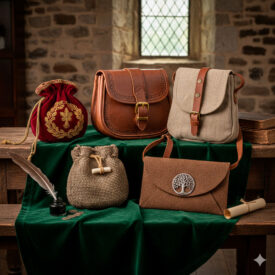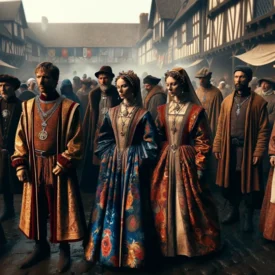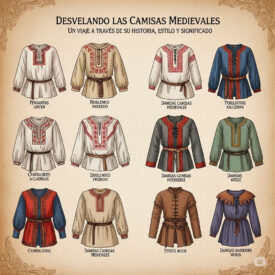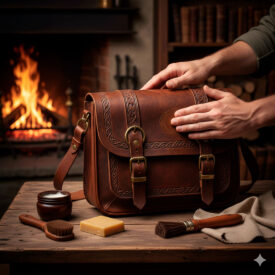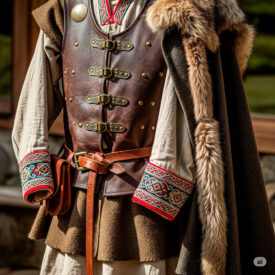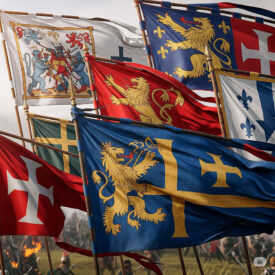In the annals of history, where castles rose and knights forged their destinies, a humble yet essential object accompanied every man and woman: the medieval bag. Far from being a mere receptacle, this accessory was a canvas that narrated stories of status, wealth, and purpose. Do you dare to unravel the secrets they held and choose the one that best reflects your own saga?
The Essence of the Medieval Bag: Functionality and Social Marker
Bags in the Middle Ages were not a whim, but an imperative necessity. The clothing of the time, lacking pockets as we know them today, demanded ingenious solutions to transport the most precious belongings. From coins and documents to relics and tools, everything found its place in these ingenious receptacles. But beyond its practical utility, each bag was a reflection of the status and position of its bearer in the social hierarchy.
Materials that Speak of Wealth and Humility
The manufacture of a medieval bag began with the choice of material, a detail that alone already betrayed the social condition of its owner. Leathers, fabrics, and furs made up the range of options, each with its own symbolism and cost.
Leather: The Symbol of Resistance and Esteem
Leather was the material par excellence, valued for its durability and ease of work. However, not all leathers were equal:
- Goat or Cordovan Leather: Reserved for elites and wealthy classes, cordovan, a goat leather tanned with a special technique, was a luxury material appreciated for its softness and resistance.
- Boiled Leather (Cuir Bouilli): A leather hardened by a cooking process, ideal for purses or pieces that required greater rigidity and the ability to stamp intricate designs.
- Calfskin: Used in various manufactures, from hanging straps to the panels of flap bags, it was a medium-quality material with great versatility.
- Cowhide: More accessible and robust, cowhide was the preferred option for less affluent classes, offering durability without the cost of finer leathers.
- Common animal hides: Peasant classes resorted to hides of small, abundant animals such as weasel, rabbit, or lamb, which, though modest, perfectly fulfilled their function.
Fabrics: From the Roughness of Labor to Noble Opulence
Fabrics also played a crucial role, varying from humble to more sumptuous weaves:
- Linen, Wool, and Cotton: Natural fibers that formed the base of bags for popular classes, resistant and adaptable for daily use.
- Silk and Velvet: High-status materials, often combined with opulent embroidery. Byzantine influence introduced these exquisite fabrics to Europe, transforming bags into small works of art. These were adorned with gold and silver threads, sometimes even with precious stones, reflecting the power and wealth of the nobility.
- Common and coarse fabrics: For the humblest classes, fabrics such as serge, sackcloth, or tow became simple but effective bags, perfect for field work or transporting basic goods.
| Material | Social Status | Characteristics |
|---|---|---|
| Silk and Velvet | Wealthy classes, High society | Rich embroidery, Byzantine influence, fine fabrics. |
| Goat Leather / Cordovan | Wealthy classes, Nobility | Considered leather for the wealthiest, very resistant. |
| Boiled Leather (Cuir Bouilli) | General use for purses | Hardened leather, suitable for stamped designs. |
| Calfskin | General use | Versatile, for straps and bag panels. |
| Common Fabrics (Linen, Wool, Cotton) | Popular classes, Peasants | Natural fibers, functional and resistant. |
| Cowhide | Less wealthy classes | Durable, economical option. |
| Common Animal Hides (Rabbit, Lamb) | Peasants | Accessible, simple, and functional materials. |
- Silk and Velvet
-
- Social Status: Wealthy classes, High society
- Characteristics: Rich embroidery, Byzantine influence, fine fabrics.
- Goat Leather / Cordovan
-
- Social Status: Wealthy classes, Nobility
- Characteristics: Considered leather for the wealthiest, very resistant.
- Boiled Leather (Cuir Bouilli)
-
- Social Status: General use for purses
- Characteristics: Hardened leather, suitable for stamped designs.
- Calfskin
-
- Social Status: General use
- Characteristics: Versatile, for straps and bag panels.
- Common Fabrics (Linen, Wool, Cotton)
-
- Social Status: Popular classes, Peasants
- Characteristics: Natural fibers, functional and resistant.
- Cowhide
-
- Social Status: Less wealthy classes
- Characteristics: Durable, economical option.
- Common Animal Hides (Rabbit, Lamb)
-
- Social Status: Peasants
- Characteristics: Accessible, simple, and functional materials.
Typologies of Bags that Told Stories
From the humble alms purse to the sophisticated Tarsoly bag, each type of bag had its purpose and place in the medieval world.
The Alms Purse: Small, Practical, and Universal
The alms purse was a small bag, often made of fabric with a drawstring to gather it, worn attached to the belt. Its name suggests its use for collecting alms in the church, but it was also where coins, rosaries, combs, or handkerchiefs were kept. Men and women of all classes used it, although the materials varied enormously.
In the 14th century, leather belt bags became popular, exclusively among men. They were robust and attached to the belt with two loops, reflecting their functional nature and their connection to work and travel. Women and the bourgeoisie, for their part, opted for bags hung from straps or hangers, which, as centuries passed, grew in size and ornamentation due to oriental influence, becoming pieces of dazzling beauty.
Barjoletas and “Pouchs”: The Diversity of Leather
Barjoletas, leather containers for solid materials or documents, showed the versatility of this material. They could even incorporate iron locks and padlocks to protect their contents. Viking or Celtic “pouchs,” small bags hung from the belt, were equally functional and reflected the aesthetics of their respective cultures.
Ornamentation: A Silent Cry of Status
While peasant bags remained sober and functional, those of the nobility were true jewels. Embroidery with gold and silver threads, inlays of precious stones, and heraldic or nature-inspired motifs not only embellished the bag but also communicated the power and wealth of its owner.
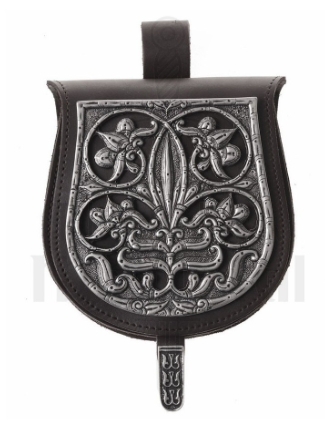
The colors were also a key indicator: bright and vibrant ones were a symbol of status, while gray and brown tones dominated among the lower classes. A luxurious bag, like one of velvet and gold, was a statement of wealth for high-ranking men, an indispensable complement to their attire.
Currently, this fascination with medieval bags persists. Historical reenactments and themed events seek authenticity and functionality, combining historical fidelity with the durability necessary for modern use. When choosing your medieval bag, you are not just acquiring an accessory, but a piece of history, a style statement, and a connection to an epic past.
Clearing up unknowns about medieval bags
What materials were most common for medieval bags?
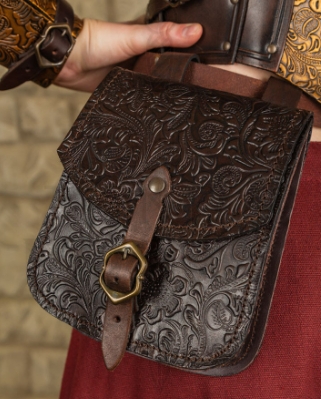 The most common materials for medieval bags were leather, canvas, and natural fabrics such as wool and linen. Leather, especially from animals like deer, pig, cow, and goat, was highly valued for its resistance and ease of work, being predominant for both practical and decorative models. For people with fewer resources, pieces of old fabric or cloth scraps were also used. Additionally, bags from high society could incorporate finer fabrics, embroidery, metallic ornaments, and velvets, reflecting social status.
The most common materials for medieval bags were leather, canvas, and natural fabrics such as wool and linen. Leather, especially from animals like deer, pig, cow, and goat, was highly valued for its resistance and ease of work, being predominant for both practical and decorative models. For people with fewer resources, pieces of old fabric or cloth scraps were also used. Additionally, bags from high society could incorporate finer fabrics, embroidery, metallic ornaments, and velvets, reflecting social status.
How did noble bags differ from peasant bags?
Noble bags differed from peasant bags mainly in materials, design, and ornamentation. While peasant bags were simple, made with available and resistant materials such as common animal hides (lamb, rabbit) or textile fibers dyed with natural elements, noble bags used select leathers (such as goat), silks, embroidered with gold and silver threads, and were adorned with precious stones. Furthermore, noble bags had more sophisticated designs and varied colors, in contrast to the more common gray or brown tones in peasant bags. The closure and shape could also be more elaborate in noble bags, which served both a practical function and to display social status. In contrast, peasants used more functional and plain bags.
What did bags symbolize in the Middle Ages?
In the Middle Ages, bags symbolized both practicality and social status. They were a practical necessity as the clothing of the time had no pockets, and both men and women used them to carry their personal belongings, such as money, everyday objects, and, in some cases, relics. Additionally, bags also reflected the social status of their owner, as the materials and decorations used varied according to social class. The most sophisticated bags, adorned with silks, gold and silver thread embroidery, and precious stones, were characteristic of the upper classes, while leather or simple fabric bags were more popular among the lower classes.
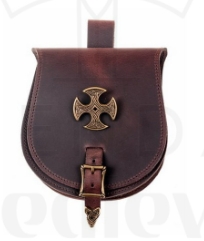 The most popular types of bags in the Late Middle Ages (11th to 15th centuries) were mainly small pouches called alms bags, used to carry money and small objects, and leather bags which could be made of goat leather for the wealthiest or cowhide for the less affluent. There were also bags decorated with silks, embroidery, and precious stones, especially in noble contexts influenced by Byzantine culture. Bags were generally practical and often hidden, as clothing had no pockets.
The most popular types of bags in the Late Middle Ages (11th to 15th centuries) were mainly small pouches called alms bags, used to carry money and small objects, and leather bags which could be made of goat leather for the wealthiest or cowhide for the less affluent. There were also bags decorated with silks, embroidery, and precious stones, especially in noble contexts influenced by Byzantine culture. Bags were generally practical and often hidden, as clothing had no pockets.
In the 14th century, two types stood out: the leather belt bag, which hung from the belt by loops, and more elaborate small bags that functioned as fashion accessories.
How did social status influence the design of medieval bags?
During the Middle Ages, social status had a significant impact on the design and materials used in bags. The upper classes preferred elaborate and sophisticated bags, often made of high-quality leathers such as deer or pig, and adorned with embroidery and decorative finishes. These bags were not only functional but also works of art that reflected the wealth and status of their owner.
On the other hand, the popular classes used simpler bags, made with less expensive materials such as old fabrics or cloth scraps. Although they were also practical, they did not have the same level of sophistication or decoration as those used by the nobility.

